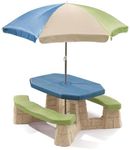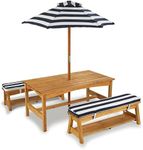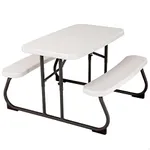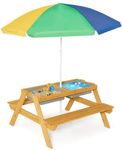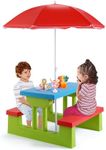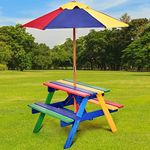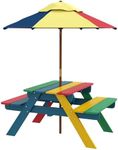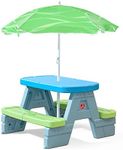Buying Guide for the Best Child Picnic Tables
Choosing a child picnic table is all about finding a safe, comfortable, and practical spot for kids to enjoy snacks, crafts, or playtime outdoors. The right table should fit your space, be easy for children to use, and stand up to the elements and active play. Before you buy, think about where you'll use it most, how many kids will use it at once, and how easy it is to clean and move. Prioritizing safety and durability will help ensure the table is a hit for years to come.MaterialThe material of a child picnic table affects its durability, weight, and maintenance needs. Common materials include plastic, wood, and metal. Plastic tables are lightweight, easy to clean, and often weather-resistant, making them great for younger kids and frequent moving. Wooden tables are sturdy and have a classic look, but may need more care to prevent splinters and weather damage. Metal tables are very durable but can get hot in the sun and may be heavier. Choose a material based on where you'll use the table (indoors or outdoors), how much maintenance you're willing to do, and the age of the children using it.
Size and Seating CapacitySize and seating capacity determine how many children can comfortably use the table at once and whether it fits your available space. Tables typically seat two to six children. Smaller tables are easier to move and store, while larger ones are better for group activities or parties. Measure your space and consider the number of kids who will use the table regularly to pick the right size. Make sure there's enough room for kids to sit and move around safely.
Safety FeaturesSafety features are crucial for child furniture. Look for rounded edges, stable construction, and non-toxic finishes. Rounded edges help prevent injuries from bumps, while a sturdy design keeps the table from tipping over during play. Non-toxic materials ensure that the table is safe if kids touch or even chew on it. Always check for safety certifications or standards to ensure the table is suitable for children.
Portability and StoragePortability and storage options make it easier to move the table indoors or outdoors and put it away when not in use. Some tables fold flat or have detachable legs, which is helpful if you have limited space or want to store the table during bad weather. Lightweight tables are easier to move but may be less stable, so balance portability with sturdiness based on your needs.
Weather ResistanceWeather resistance is important if you plan to use the table outdoors. Tables made from treated wood, certain plastics, or powder-coated metals can withstand rain, sun, and temperature changes better. If your table will stay outside, look for materials and finishes that resist fading, warping, or rusting. If you’ll bring the table inside after use, this may be less important.
Ease of CleaningEase of cleaning matters because kids can be messy. Smooth surfaces and simple designs are easier to wipe down after meals or crafts. Plastic tables are usually the easiest to clean, while wood may need more care to avoid stains. Consider how much time you want to spend on maintenance and pick a table that matches your expectations.


